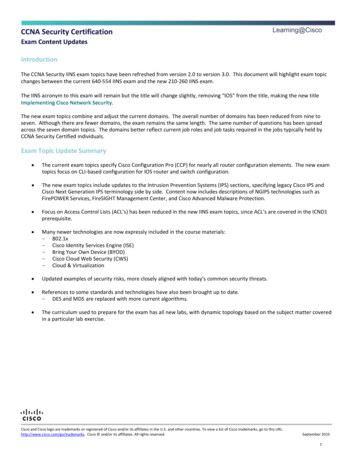
Transcription
AZ-500 Exam Topics Review QuestionsUpdated: com/2021/06/az-500-exam-all.pdfContentsAZ-500 Exam Topics Review Questions . 11. Stored access policy . 32. Same as 1 . 33. Connect HDInsight to your on-premises network . 34. Same as 3 . 45. Password hash synchronization with seamless single sign-on (SSO). 46. Synchronization Rules Editor . 57. Conditional access policies. 58. Azure AD Identity Protection user risk policy . 69. Access Review . 810. Access Review . 911. Privileged Identity Management (PIM). 1112. Conditional Access and MFA . 1313. Azure AD Privileged Identity Management (PIM) . 1414. Uploading and downloading images to a Registry. 1415. Configure Azure DNS to host a custom domain for your web apps . 1516. Stored Access Policy . 1517. Connect HDInsight to your on-premises network . 1618. Identify which roles and groups are required to configure AD Connect . 1619. Same as 11 . 1720. Same as 3 . 1721. Same as 1 . 1722. Azure AD Privileged Identity Management (PIM) . 1723. SQL Authentication: Active Directory - Password . 1824. Azure Resource Manager templates: parameters file . 1825. Conditional Access Policy . 1926. Transfering the ownership of Sub1 to Admin1 . 2027. Azure Blueprints . 211
Topic 2 – Question set 2. 221. Install the container network interface (CNI) plug-in. . 222. Azure Desired State Configuration (DSC) virtual machine extension . 233. HubVNet and SpokeVNet . 244. DeployIfNotExists . 275. Configuring an Azure Kubernetes Service (AKS) cluster . 286. Resource Locking – to review . 307. Azure update management . 318. Network Security Groups (NSG) and Network Security Rules . 329. Azure Key Vault . 3510. Azure Disk Encryption . 3811. Azure Log Analytics . 4012. Azure Kubernetes Service (AKS) Cluster . 4113. Apply policies to multiple subscriptions . 4114. Deploy the policy definitions as a group to all three subscriptions . 4215. Enable and configure the Microsoft Antimalware service . 4216. Same as 15 . 4217. Azure security Center – custom alert rule . 4218. User Define route. 4319. NSG. 4420. ASG (Application Security Group) . 4621. Adaptive application controls . 4822. Container groups. 4823. Network access in VNETs and Subnets - Review . 4924. Management Groups – same as 14 . 50Topic 3 – Question Set 3 . 501. Azure Monitor Logs - Review . 502. Custom Sensitive information Type . 503. Create an Azure Log Analytics query to identify failed user sign-in attempts from the last three days 514. Azure Logic Apps Designer . 525. Create custom alert rules in Azure Security Center . 526. Metric . 537. Activity logs vs. Logs . 532
8. Alerts action rules . 549. Azure monitor insights . 5510. Just in time (JIT) VM access. 5511. Azure Network Watcher and NSG flow logs . 56References . 56ExamRef: Create a Virtual Network . 57ExamRef Summaries . 58Chapter 3: Manage Security Operations Summary . 58Chapter 4: Secure Data and Applications Summary . 58LinkedIn Courses . 59Become an Azure Security Engineer . 59AZ-500: 3 Manage Security Operations . 59Demos and Labs . 591. Stored access policyYou have an Azure Storage account named Sa1 in a resource group named RG1. Users and applicationsaccess the blob service and the le service in Sa1 by using several shared access signatures (SASs) andstored access policies.You discover that unauthorized users accessed both the le service and the blob service.You need to revoke all access to Sa1.Solution: You generate new SASs. Does this meet the goal? NoInstead, you should create a new stored access policy. To revoke a stored access policy, you can eitherdelete it, or rename it by changing the signed identifier. Changing the signed identifier breaks theassociations between any existing signatures and the stored access policy.Deleting or renaming the stored access policy immediately affects all of the shared access signaturesassociated with it.References: ervices/Establishing-a-Stored-AccessPolicy2. Same as 13. Connect HDInsight to your on-premises networkYou have a hybrid configuration of Azure Active Directory (Azure AD). You have an Azure HDInsightcluster on a virtual network. You plan to allow users to authenticate to the cluster by using their on-3
premises Active Directory credentials. You need to configure the environment to support the plannedauthentication.Solution: You deploy the On-premises data gateway to the on-premises network. Does this meet thegoal? NOInstead, you connect HDInsight to your on-premises network by using Azure Virtual Networks and a VPNgateway.Note: To allow HDInsight and resources in the joined network to communicate by name, you mustperform the following actions: Create Azure Virtual Network. Create a custom DNS server in the Azure Virtual Network. Configure the virtual network to use the custom DNS server instead of the default Azure RecursiveResolver. Configure forwarding between the custom DNS server and your on-premises DNS server.References: onnect-on-premises-network4. Same as 35. Password hash synchronization with seamless single sign-on (SSO)You plan to deploy Azure AD Connect and to integrate Active Directory and the Azure AD tenant. Youneed to recommend an integration solution that meets the following requirements: Ensures that password policies and user logon restrictions apply to user accounts that are synced tothe tenant Minimizes the number of servers required for the solution.Password hash synchronization requires the least effort regarding deployment, maintenance, andinfrastructure. This level of effort typically applies to organizations that only need their users to sign intoOffice 365, SaaS apps, and other Azure AD-based resources. When turned on, password hashsynchronization is part of the Azure AD Connect sync process and runs every two minutes.A federated authentication system relies on an external trusted system to authenticate users. Somecompanies want to reuse their existing federated system investment with their Azure AD hybrid identitysolution. The maintenance and management of the federated system falls outside the control of AzureAD. It's up to the organization by using the federated system to make sure it's deployed securely andcan handle the authentication load.For pass-through authentication, you need one or more (we recommend three) lightweight agentsinstalled on existing servers. These agents must have access to your on-premises Active DirectoryDomain Services, including your on-premises AD domain controllers. They need outbound access to theInternet and access to your domain controllers. For this reason, it's not supported to deploy the agentsin a perimeter network.4
Pass-through Authentication requires unconstrained network access to domain controllers. All networktrac is encrypted and limited to authentication requests.References: ctory/hybrid/how-to-connect-pta6. Synchronization Rules EditorYou need to prevent users who have a givenName attribute that starts with TEST from being synced toAzure AD. The solution must minimize administrative effort.What should you use?Use the Synchronization Rules Editor and write attribute-based filtering rule. -theconguration7. Conditional access policies.You must evaluate the existing Azure Active Directory (Azure AD) risk events and risk levels to configureand implement the policies.You need to identify the risk level of the following risk events: Users with leaked credentials Impossible travel to atypical locations Sign-ins from IP addresses with suspicious activityWhich level should you identify for each risk event?Azure AD Identity protection can detect six types of suspicious sign-in activities:1.2.3.4.5.6.Users with leaked credentialsSign-ins from anonymous IP addressesImpossible travel to atypical locationsSign-ins from infected devicesSign-ins from IP addresses with suspicious activitySign-ins from unfamiliar locationsThese six types of events are categorized in to 3 levels of risks: High, Medium & Low5
8. Azure AD Identity Protection user risk policyYou create and enforce an Azure AD Identity Protection user risk policy that has the following settings: Assignment: Include Group1, Exclude Group2 Conditions: Sign-in risk of Medium and aboveAccess: Allow access, Require password changeYou have an Azure Active Directory (Azure AD) tenant named contoso.com that contains the usersshown in the following table:6
7
9. Access ReviewYou need to configure an access review. The review will be assigned to a new collection of reviews andreviewed by resource owners.Which three actions should you perform in sequence? To answer, move the appropriate actions fromthe list of actions to the answer area and arrange them in the correct order.Step 1: Create an access review programStep 2: Create an access review controlStep 3: Set Reviewers to Group owners8
In the Reviewers section, select either one or more people to review all the users in scope. Or you canselect to have the members review their own access. If the resource is a group, you can ask the groupowners to directory/governance/manage-programs-controls10. Access ReviewYou have an Azure Active Directory (Azure AD) tenant named contoso.com. The tenant contains theusers shown in the following table.9
References:10
o-start-security-review11. Privileged Identity Management (PIM)You need to ensure that you can use Azure Active Directory (Azure AD) Privileged Identity Management(PIM) to secure Azure AD roles.Which three actions should you perform in sequence? To answer, move the appropriate actions fromthe list of actions to the answer area and arrange them in the correct order.11
References: arted12
12. Conditional Access and MFAReferences: cing-mfa/13
13. Azure AD Privileged Identity Management (PIM)Your company plans to create separate subscriptions for each department. Each subscription will beassociated to the same Azure Active Directory (Azure AD) tenant.You need to configure each subscription to have the same role assignments. What should you use?The Azure AD Privileged Identity Management (PIM) service also allows Privileged Role Administratorsto make permanent admin role assignments.References: -role-to-user14. Uploading and downloading images to a RegistryYou have an Azure Container Registry named Registry1. You add role assignment for Registry1 as shownin the following table.Box 1: User1 and User4 only - Owner, Contributor and AcrPush can push images.Box 2: User1, User2, and User4 - All, except AcrImagineSigner, can download/pull images14
References: ner-registry/container-registry-roles15. Configure Azure DNS to host a custom domain for your web appsYou create an Azure web app named Contoso1812 that uses an S1 App service plan. You create a DNSrecord for www.contoso.com that points to the IP address of Contoso1812. You need to ensure thatusers can access Contoso1812 by using the https://www.contoso.com URL.Which two actions should you perform? Each correct answer presents part of the solution. B. Add a hostname to Contoso1812.E. Scale up the App Service plan of Contoso1812.You can configure Azure DNS to host a custom domain for your web apps. For example, you can createan Azure web app and have your users access it using either www.contoso.com or contoso.com as afully qualified domain name (FQDN). To do this, you have to create three records:1. A root "A" record pointing to contoso.com2. A root "TXT" record for verification3. A "CNAME" record for the www name that points to the A recordE: To map a custom DNS name to a web app, the web app's App Service plan must be a paid tier(Shared, Basic, Standard, Premium or Consumption for AzureReferences: -sites-custom-domain16. Stored Access PolicyYou have an Azure Storage account named Sa1 in a resource group named RG1. Users and applicationsaccess the blob service and the file service in Sa1 by using several shared access signatures (SASs) andstored access policies.You discover that unauthorized users accessed both the file service and the blob service. You need torevoke all access to Sa1.Solution: You create a lock on Sa1. Does this meet the goal? No15
To revoke a stored access policy, you can either delete it, or rename it by changing the signed identifier.Changing the signed identifier breaks the associations between any existing signatures and the storedaccess policy. Deleting or renaming the stored access policy immediately affects all of the shared accesssignatures associated with it.References: ervices/Establishing-a-Stored-AccessPolicy17. Connect HDInsight to your on-premises networkYou have a hybrid configuration of Azure Active Directory (Azure AD). You have an Azure HDInsightcluster on a virtual network. You plan to allow users to authenticate to the cluster by using their onpremises Active Directory credentials.You need to configure the environment to support the planned authentication.Solution: You deploy Azure Active Directory Domain Services (Azure AD DS) to the Azure subscription.Does this meet the goal? NOInstead, you connect HDInsight to your on-premises network by using Azure Virtual Networks and a VPNgateway.Note: To allow HDInsight and resources in the joined network to communicate by name, you mustperform the following actions: Create Azure Virtual Network. Create a custom DNS server in the Azure Virtual Network. Configure the virtual network to use the custom DNS server instead of the default Azure RecursiveResolver. Configure forwarding between the custom DNS server and your on-premises DNS server.References: onnect-on-premises-network18. Identify which roles and groups are required to configure ADConnectYou plan to configure synchronization by using the Express Settings installation option in Azure ADConnect. You need to identify which roles and groups are required to perform the plannedconfiguration. The solution must use the principle of least privilege.Which two roles and groups should you identify? The Global administrator role in Azure AD andThe Enterprise Admins group in Active DirectoryReferences: 16
19. Same as 1120. Same as 321. Same as 122. Azure AD Privileged Identity Management (PIM)Selected approver: Group117
Box 1: Yes - Active assignments don't require the member to perform any action to use the role.Members assigned as active have the privileges assigned to the role at all times.Box 2: No - MFA is disabled for User2 and the setting Require Azure Multi-Factor Authentication foractivation is enabled. Note: Eligible assignments require the member of the role to perform an action touse the role. Actions might include performing a multi-factor authentication (MFA) check, providing abusiness justication, or requesting approval from designated approvers.Box 3: Yes - User3 is Group1, which is a Selected Approver GroupReference: rce-roles-assign-roles23. SQL Authentication: Active Directory - PasswordYou have a hybrid configuration of Azure Active Directory (Azure AD). You have an Azure SQL Databaseinstance that is configured to support Azure AD authentication.Database developers must connect to the database instance and authenticate by using their onpremises Active Directory account.You need to ensure that developers can connect to the instance by using Microsoft SQL ServerManagement Studio.The solution must minimize authentication prompts.Which authentication method should you recommend?Use Active Directory password authentication when connecting with an Azure AD principal name usingthe Azure AD managed domain. Use this method to authenticate to SQL DB/DW with Azure AD fornative or federated Azure AD users. A native user is one explicitly created in Azure AD and beingauthenticated using user name and password, while a federated user is a Windows user whose domainis federated with Azure AD.The latter method (using user & password) can be used when a user wants to use their windowscredential, but their local machine is not joined with the domain (for example, using a remote access). Inthis case, a Windows user can indicate their domain account and password and can authenticate to SQLDB/DW using federated credentials.Use Active Directory integrated authentication if you are logged in to Windows using your Azure ActiveDirectory credentials from a federated domain.References: e/sql-database-aad-authenticationcongure24. Azure Resource Manager templates: parameters fileYou plan to use Azure Resource Manager templates to perform multiple deployments of identicallyconfigured Azure virtual machines. The password for the administrator account of each deployment isstored as a secret in different Azure key vaults. You need to identify a method to dynamically construct a18
resource ID that will designate the key vault containing the appropriate secret during each deployment.The name of the key vault and the name of the secret will be provided as inline parameters.What should you use to construct the resource ID?Reference: rce-manager/resource-managerkeyvault-parameter25. Conditional Access PolicyYou create one active conditional access policy named Portal Policy. Portal Policy is used to provideaccess to the Microsoft Azure Management cloud app. The Conditions settings for Portal Policy areconfigured as shown in the Conditions exhibit. (Click the Conditions tab.)19
26. Transfering the ownership of Sub1 to Admin1You have an Azure subscription named Sub1 that is associated to an Azure Active Directory (Azure AD)tenant named contoso.com. An administrator named Admin1 has access to the following identities:20
You plan to use Azure Account Center to transfer the ownership of Sub1 to Admin1. To which accountscan you transfer the ownership of Sub1? Contoso.com and fabrikam.com onlyWhen you transfer billing ownership of your subscription to an account in another Azure AD tenant, youcan move the subscription to the new account's tenant. If you do so, all users, groups, or serviceprincipals who had role based access (RBAC) to manage subscriptions and its resources lose their access.Only the user in the new account who accepts your transfer request will have access to manage theresources.Reference: r-azure-ad-tenant27. Azure BlueprintsYour company plans to create separate subscriptions for each department. Each subscription will beassociated to the same Azure Active Directory (Azure AD) tenant. You need to configure eachsubscription to have the same role assignments. What should you use?Just as a blueprint allows an engineer or an architect to sketch a project's design parameters, AzureBlueprints enables cloud architects and central information technology groups to define a repeatable setof Azure resources that implements and adheres to an organization's standards, patterns, andrequirements.Blueprints are a declarative way to orchestrate the deployment of various resource templates and otherartifacts such as: Role Assignments Policy Assignments Azure Resource Manager templates Resource GroupsReference: blueprints/overviewConfigure security settings by using Azure /exam-ref-az-500/9780136789000/ch03.xhtml21
Azure Blueprints enable you to define a repeatable set of Azure resources that implement and adhereto an organization’s standards, patterns, and requirements. It is very important for you to understandwhen to use a blueprint instead of a policy. Blueprints are used to orchestrate the deployment ofvarious resource templates and other artifacts, such as role assignments, policy assignments, AzureResource Manager templates, and resource groups.The main difference between a blueprint and a policy is that a blueprint is a package for composingfocus-specific sets of standards, patterns, and requirements related to the implementation of Azurecloud services, security, and design.Another characteristic of the blueprint is that you can reuse them to maintain consistency andcompliance. A policy can be included in this package as an artifact for the blueprint.Both can be utilized in scenarios where you have multiple subscriptions and want to maintaingovernance. From the lifecycle perspective, a blueprint has these major stages:Follow these steps to create a new blueprint and publish it: Navigate to the Azure portal at https://portal.azure.comIn the search bar, type blueprint, and under Services, click Blueprints.Topic 2 – Question set 21. Install the container network interface (CNI) plug-in.You have an Azure subscription named Sub1. Sub1 contains a virtual network named VNet1 thatcontains one subnet named Subnet1.Subnet1 contains an Azure virtual machine named VM1 that runs Ubuntu Server 18.04. You create aservice endpoint for MicrosoftStorage in Subnet1. You ne
Jun 16, 2021 · E. Scale up the App Service plan of Contoso1812. You can configure Azure DNS to host a custom domain for your web apps. For example, you can create an Azure web app and have your users access it using either www.contoso.com or contoso.com as a fully qualified domain n











